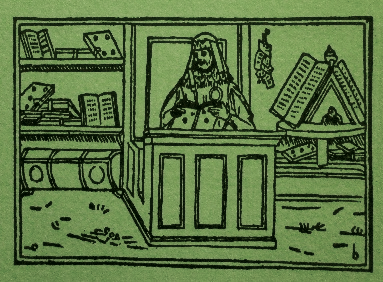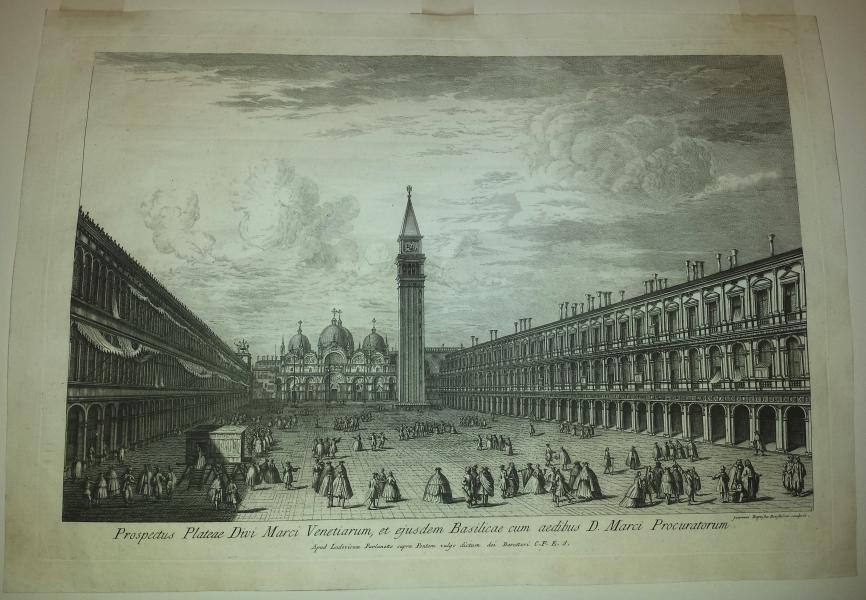Incisione su rame all’acquaforte e bulino di mm 458 x 314 mm alla battuta, su carta di filo. Foglio 490 x 350 mm. Foglio candido e forte. Primo stato su quattro. Tavola da Prospectuum Aedium Viarumque Insigniorum Urbis Venetiarum raccolta di vedute edita per la prima volta nel 1763 con un frontespizio e dodici incisioni derivate dal Canaletto e copiate dalla visione che ne dette il Visenini. Originario del bellunese Giambattista Brustolon nacque a Venezia nel 1712.Secondo il Moschini il suo apprendistato si svolse presso quella fucina di geni che fu la bottega del Wagner; certamente egli cominciò ad applicarsi all’intaglio in giovane età: nel 1730, appena diciottenne incise con notevole abilità il ritratto del conte friulano Francesco Beretta. Come illustratore di libri dimostrò una abilità fuori dal comune, tanto che nel 1767 venne incaricato dal Console Britannico Joseph Smith, mecenate o meglio procuratore di Canaletto, a realizzare le cento tavole rappresentanti le sue gemme e cammei pubblicato sotto il titolo di Dactyliotheca Smithiana. Nel 1763 uscì con l’album “Prospectum Aedium Viarumque insigniorum Urbis Venetiarum”, dedicate al Doge Marco Foscarini, prima in dodici vedute, da Canaletto, quindi in ventidue, da disegni o pitture di Marieschi e Moretti. Dal 1766 realizzò l’altra grande opera della sua carriera: le “Feste Dogali”, da disegni acquerellati di Canaletto. L’artista morì a Venezia “nella contrada di San Cancian” il 16 ottobre 1796 “per frequenti accessi di colica nefritica”, come risulta dall’atto conservato in quella parrocchia. Alpago-Novello : ” Ove si confrontino le incisioni del Brustolon con quelle dei medesimi originali del Canaletto trassero Giampiccoli o il Sandi, bisogna riconoscere al Nostro un’ariosità e pastosità superiori, inisiema ad una più sicura distribuzione e graduazione dei chiaroscuri: una eminente personalitò artistica insomma”.Pignatti: “Brustolon seppe rendere spesso la trasparenza dei cieli del Canaletto, e la luminosa brillantezza delle architetture. Fece uso notevole del bulino e di ripetute morsure, spesso avvicinandosi ad effetti di acquatinta”.Etching copper engraving and burin 458 x 314 mm at the stroke, on wire paper. Sheet 490 x 350 mm. White and strong sheet. First state out of four. Table from Prospectuum Aedium Viarumque Insigniorum Urbis Venetiarum collection of views published for the first time in 1763 with a title page and twelve engravings derived from Canaletto and copied from the vision that Visenini gave of it. Originally from Belluno, Giambattista Brustolon was born in Venice in 1712. According to Moschini, his apprenticeship took place at that forge of geniuses that was Wagner’s workshop; he certainly began to apply himself to carving at a young age: in 1730, at the age of eighteen, he engraved the portrait of the Friulian count Francesco Beretta with remarkable skill. As a book illustrator he demonstrated an out of the ordinary skill, so much so that in 1767 he was commissioned by the British Consul Joseph Smith, patron or better procurator of Canaletto, to create the hundred tables representing his gems and cameos published under the title of Dactyliotheca Smithiana. In 1763 he came out with the album “Prospectum Aedium Viarumque insigniorum Urbis Venetiarum”, dedicated to Doge Marco Foscarini, first in twelve views, by Canaletto, then in twenty-two, from drawings or paintings by Marieschi and Moretti. From 1766 he created the other great work of his career: the “Feste Dogali”, from Canaletto’s watercolor drawings. The artist died in Venice “in the district of San Cancian” on October 16, 1796 “from frequent attacks of nephritic colic”, as shown in the deed preserved in that parish. Alpago-Novello: “If one compares the engravings of Brustolon with those of the same originals by Canaletto drawn by Giampiccoli or Sandi, we must recognize our superior airiness and softness, combined with a more secure distribution and graduation of the chiaroscuro: an eminent personality in short, artistic “. Pignatti:” Brustolon was often able to convey the transparency of the skies of Canaletto, and the luminous brilliance of the architecture. He made considerable use of the burin and repeated etching, often approaching the effects of aquatint
Libreria Emiliana
Antiquaria
Libri e Stampe Veneziane
dal XV al XXI Secolo
dal XV al XXI Secolo


